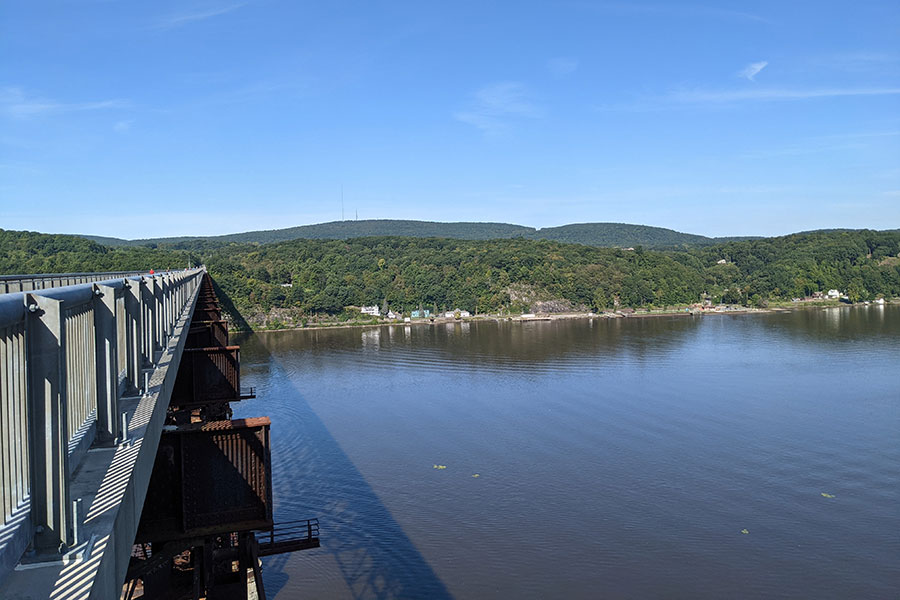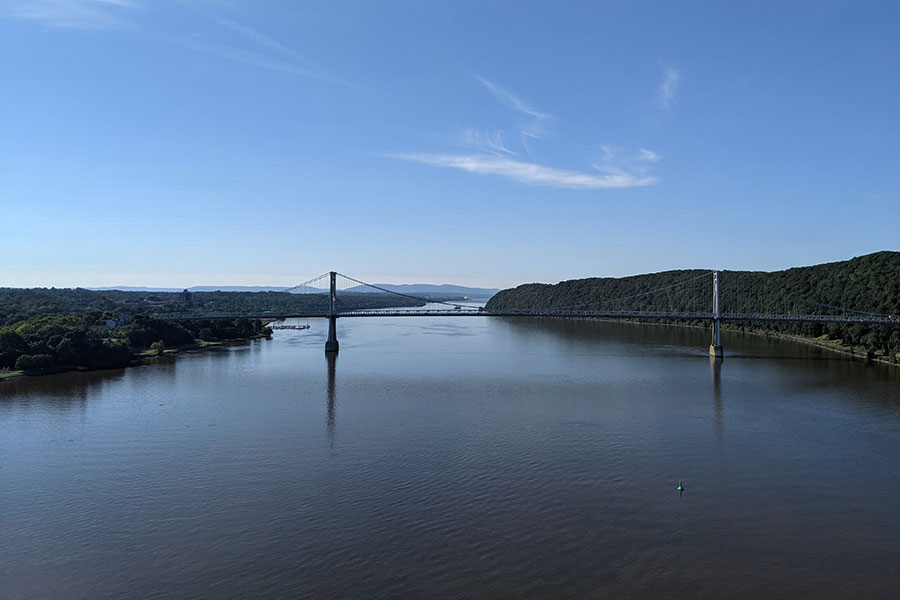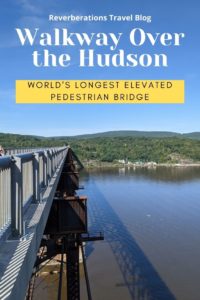Rail trails are seemingly popping up everywhere these days. And with good reason, as people look to get outdoors and disused structures are repurposed for modern life. With these spots, people can stretch their legs for a walk, run, or ride. Perhaps one of the most dramatic rail trails is the Walkway Over the Hudson bridge. The steel bridge, spanning the Hudson River and connecting Poughkeepsie and Highland, New York, is one of the longest pedestrian footbridges in the world. And with stunning unobstructed 360-degree views from over 200 feet over the waterway, it is a day trip from NYC that is worth putting on your bucket list.
A Brief History
In 1889, a steel cantilever railroad bridge opened over the Hudson River. The Poughkeepsie Bridge, as it was known, was part of the Maybrook line that ultimately connected Maybrook, NY, with Derby, CT.
A bridge over the Hudson River was discussed for years but considered unrealistic. Eventually, however, the ambitious bridge came to fruition. Over a distance of 6,768 feet, there are seven spans, making it the longest footbridge until 2016. The top surface of the bridge is 212 feet above the water.
It was a remarkable feat of engineering using then-new steel processing techniques. And until the mid-1920s, it was the only fixed bridge over the Hudson River between Albany and New York City, serving both freight and passengers.
But over the decades of decreased use and, finally being damaged by a fire, the Poughkeepsie Bridge went out of service in 1974. Despite falling into disrepair, the bridge was still acknowledged as something special. In 1978, it was added to the National Register of Historic Places.
The bridge changed hands multiple times and different uses were floated for the now disused bridge. But in 1998, following legal battles and unpaid taxes, the bridge was given to Walkway Over the Hudson, a nonprofit volunteer group.
And that’s when the real work began. But in order to convert the structure from a rail bridge to a rail trail, a lot of work was needed.
And money. A mixture of public and private funds were raised, including a donation of nearly $20 million from the Dyson Foundation. The bridge was evaluated and renovations were completed in multiple phases. On October 3, 2009, the Walkway Over the Hudson State Park officially opened. It is part of the Hudson Valley Rail Trail Network.
Experiencing the Walkway Over the Hudson
My visit to the Walkway Over the Hudson was an unexpected but fun surprise. During a breakfast stop at Kelly’s Bakery in Poughkeepsie, the sky-high bridge caught my eye. But what really caught my attention was that there were no cars or trains on the bridge. There were only pedestrians!
Well, a detour to our road trip to this impressive bridge was in order. Quebec City could wait another hour.
The trail is quite popular, especially on a clear and pleasant Saturday morning in September. Most visitors will no doubt see the rail trail as an outdoor activity for getting some exercise, perhaps while meeting up with friends. But the 1.28-mile park offers far more.
There is that stunning view over the Hudson River. From the wide concrete slabs that now make up the surface of the former railway bridge, visitors can enjoy generous 360-degree views that seem to go on forever. You can peer over the nearby towns that are nestled along the riverbanks and the Catskills, watch the vessels that sail up and down the waterway, or simply appreciate the river itself.
Then, of course, there is the historical aspect of the bridge. It is the Walkway Over the Hudson State Historic Park, after all. The architecture and engineering of the bridge can be appreciated from below and, carefully, from above. Signs posted along the trail offer details, both historical and informative. They point out sites of interest, including where Henry Hudson and his crew once sailed.
At roughly two hours by car, the Hudson River Valley is always a popular day trip from New York City. And with good reason. In addition to the rail trail, there are historic sites, opportunities for outdoor adventures, and plenty of cultural and culinary delights.
But there is more to this park than just the trail. Picnic tables and benches turn this into a community meeting spot – or a road trip detour – where you can hang out or relax under mature trees.
Getting There
Unsurprisingly, there are two ways to get to the bridge. You can enter from Poughkeepsie or from Highland.
For Walkway Over the Hudson parking, there are a couple of options. Because the bridge is part of the New York State Park system, the closest parking on both sides is paid parking. The Poughkeepsie side has an automated system that accepts cash and credit/debit cards while the Highland side is a cash-only dropbox.
If you don’t mind walking a little further, there are a limited number of free spots in parking lots and on the street on both sides of the walkway. On the Poughkeepsie side, there’s unpaved free parking just before you get to the metered lot. The free lot is not too much farther from the trail than the paid lot.
If you’re approaching from the street on the Poughkeepsie side at the Hudson River waterfront, there’s a 21-story elevator that will take you up to the trail while offering stunning views from the glass panel walls. If you don’t want to take the elevator, don’t worry. You won’t have to deal with 21 flights of stairs. The bridge is built on a gentle incline so a ramp will take you up to the top.
Save this post for later with Pinterest!
All photos, as well as opinions, are my own.


